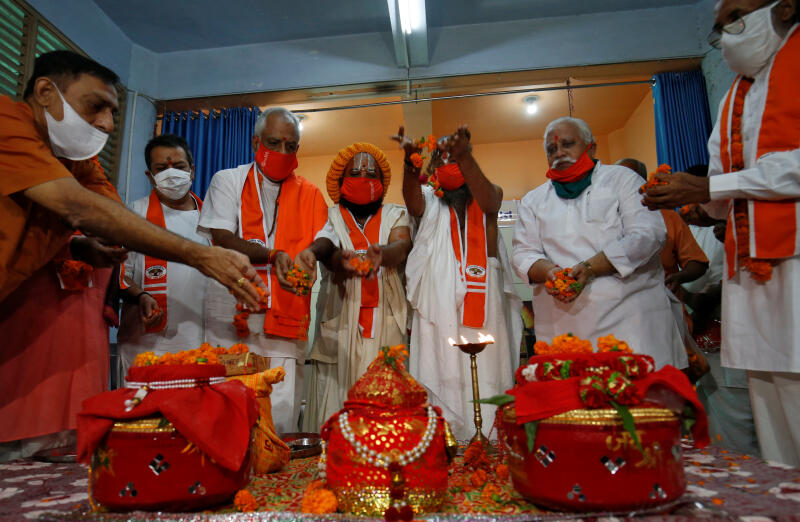Temple construction to begin in Ayodhya, once at the heart of a bitter dispute between Hindus and Muslims
Sign up now: Get insights on Asia's fast-moving developments

Hindu priests and supporters of the Vishva Hindu Parishad perform rituals before taking the pots to Ayodhya for a ceremony in the Ram Temple, in Ahmedabad, India, on July 27, 2020.
PHOTO: REUTERS
Follow topic:
NEW DELHI - Thirty years ago, Indian architect Chandrakant B. Sompura designed a temple for Lord Ram for the city of Ayodhya in the state of Uttar Pradesh.
Together with Mr Ashok Singhal, leader of the right-wing Vishwa Hindu Parishad (VHP) who had contacted him and who has since died, Mr Sompura travelled to Ayodhya to map the land, which was at the heart of a centuries-old dispute between Hindu and Muslim groups.
The design was in place well before the bitter land dispute was resolved and before a Hindu mob destroyed the Babri Masjid, a 16th-century mosque, at the site, triggering communal riots in which more than 2,000 people were killed.
Now construction of the temple, based on Mr Sompura's design, is set to start, nine months after the Supreme Court handed over the disputed land to Hindu groups and asked the federal and Uttar Pradesh state government to provide alternate land of five acres to Muslims groups in Ayodhya.
On Aug 5, a Bhumi Pujan - a ritual that is performed before construction can begin - will take place at Ayodhya.
Prime Minister Narendra Modi is likely to be among 200 people who will take part in the ritual, capping a core promise of his Bharatiya Janata Party (BJP) to its Hindu supporters to build the temple.
Mr Sompura's design from 30 years ago has remained, except for the size of the temple.
"Everyone feels the area where the darshan (the act of seeing the deity) takes place is small. After 30 years, the population has increased too much, there has been so much media coverage of the Ram mandir (temple) and the footfall of people will be much more than in 1990," said Mr Sompura's son, architect Ashish Sompura.
"So we all have decided to do a new floor area. We don't want to change the original design as people have been imaging that model for 30 years."
He is working with his father to update the design, with two additional domes for a total of five, and a floor area of 30,000 sq ft.
In 1990, he said, his father had designed the temple to accommodate 30,000 to 60,000 worshippers per day. Now they expect 80,000 to 100,000 people every day.
"We also studied the most-visited temples of India like the Golden Temple, Somnath temple and Tirupati and the daily footfalls before we decided this is the area we want."
Mr Sompura, whose father's portfolio includes design of the Shiv Temple in Singapore, said the temple will be built entirely of pink sandstone and will take 3½ years to complete.
So far, construction of the mosque at an alternate site has not started.
The Uttar Pradesh Sunni Central Waqf Board on Wednesday announced the formation of a trust to oversee the construction of the mosque at an alternate site in Ayodhya. Land has been given by the government in Dhannipur village, 24km from the original site, in Ayodhya.
The BJP came to national prominence after Hindu hardliners razed the mosque on Dec 6, 1992, plunging the country into months of communal rioting. Anti-Hindu protests over the incident took place in Pakistan, Bangladesh and elsewhere at the time.
A case is still ongoing against VHP and BJP party leaders for the conspiracy to demolish the mosque.
The beginning of construction, said political analysts, would also be a reprieve for Mr Modi, who is battling the twin challenges of the surging coronavirus cases and the ailing economy.
"It's an opportunity to talk about something besides Covid-19," said political analyst Nilanjan Mukhopadhyay.
He said the Ram temple was part of a wider platform of the BJP to promote "religio-cultural nationalism", whereby the mix of religion and culture is held up as the epitome of India. "Anybody who raises an obstacle is anti-India," he said.
The construction of the temple has been used as a political tool by the BJP to consolidate Hindu votes in parts of northern India.
Still, the beginning of construction during a pandemic has attracted criticism from some political opponents. India has more than 1.5 million coronavirus cases, with numbers continuing to climb.
Accusing the BJP of using the Ram Temple as electioneering, Maharashtra chief minister Uddhav Thackeray said in an interview published in his party Shiv Sena mouthpiece, Saamana, on Sunday that the ground-breaking ceremony could be held through video-conference.
"This is an event of joy," he said. "Will we allow the spread of coronavirus?"
All India Majlis-e-Ittehadul Muslimeen president Asaduddin Owaisi also urged Mr Modi not to attend the ceremony in his official capacity but as a private citizen, noting that a "message will go in the country that the PM is supporting people of one faith only".
The BJP has dismissed all criticism from the opposition.
"These comments by various opposition leaders are uncalled for, because the Prime Minister has attended several religious functions, not just of the Hindu faith in the past also. To draw the Ram temple into a political discourse is neither desirable nor necessary," said BJP spokesman Nalin Kohli.

